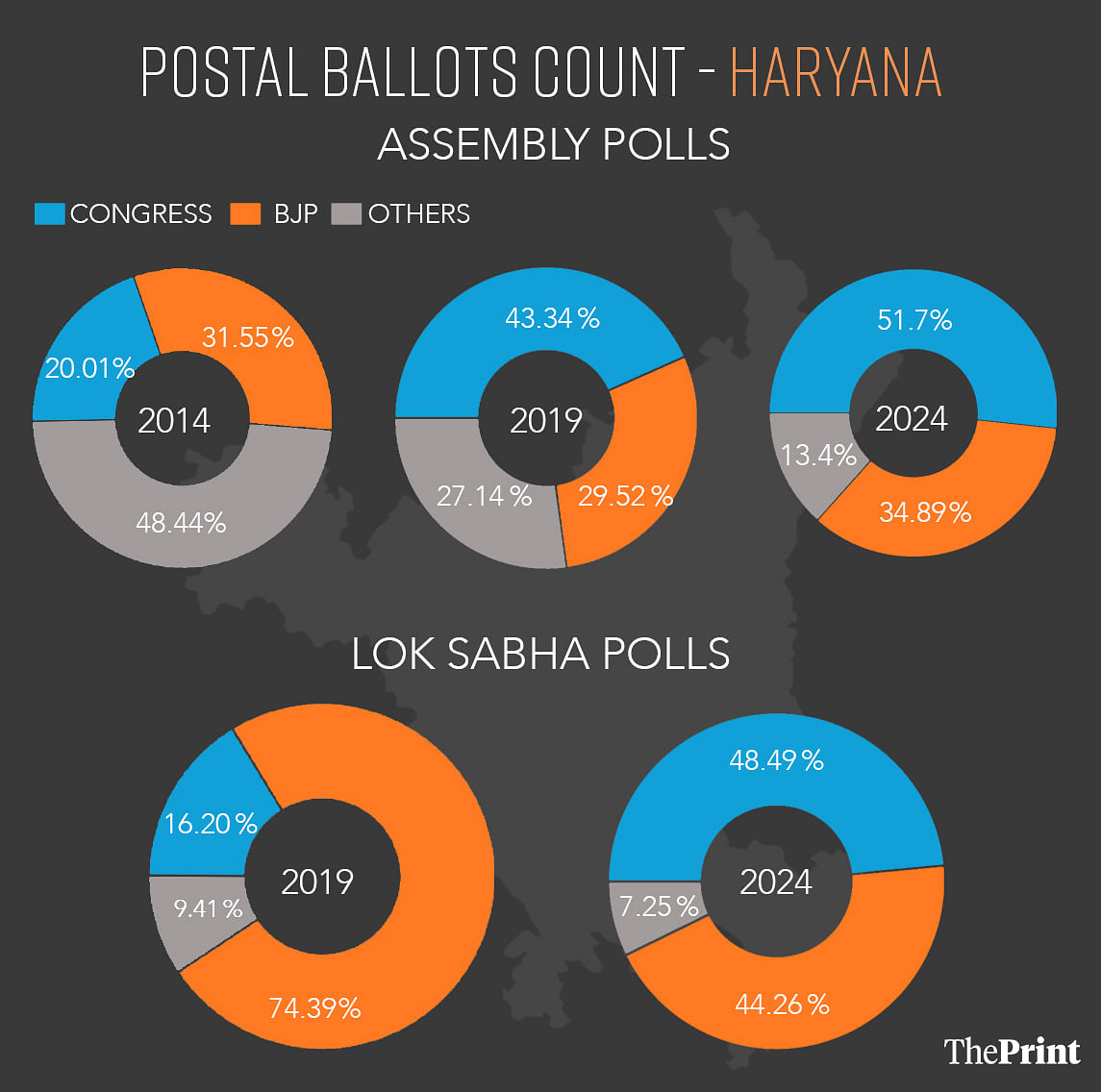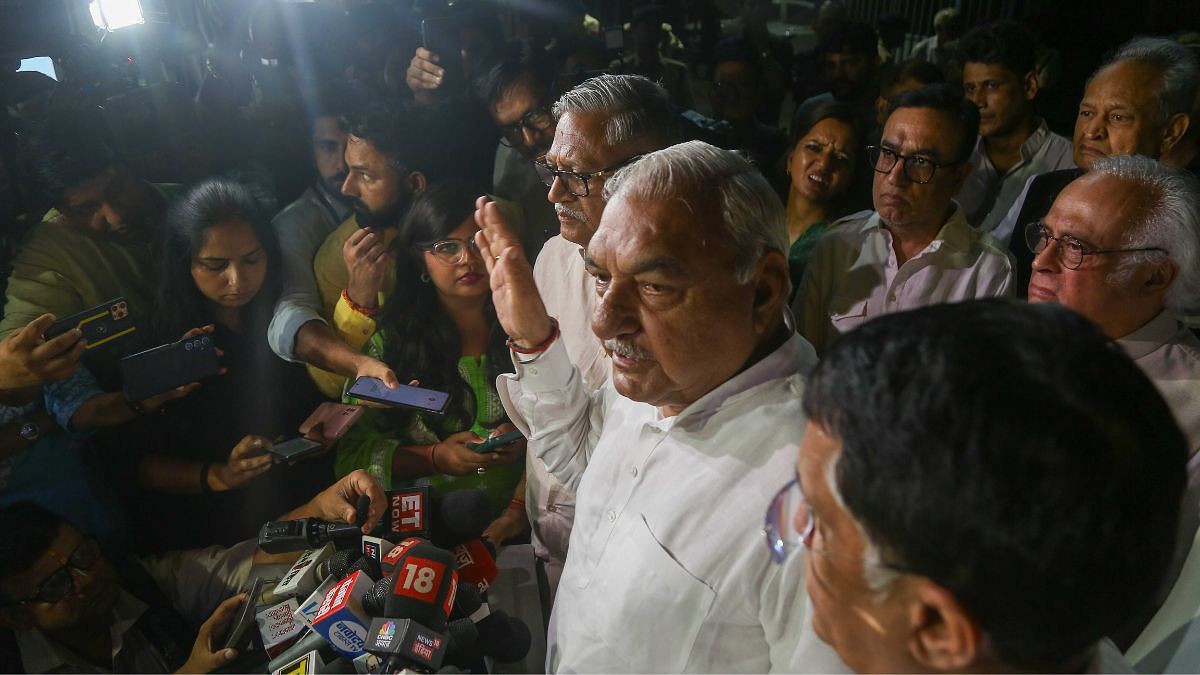New Delhi: Even as it failed to win, the Congress bagged 51.7 percent of the postal ballots cast in the Haryana assembly elections, markedly more than the 34.89 percent of the Bharatiya Janata Party (BJP)—which has returned to power for the third straight term with a comfortable majority—according to Election Commission data.
The Congress won more postal ballots—which accounted for only 0.57 percent of the total votes cast—than the BJP in as many as 74 of the 90 assembly seats in Haryana.
In terms of total vote share, which takes into account both postal ballots and votes cast through electronic voting machines (EVMs), the two parties were neck and neck, with the BJP securing 39.94 percent against the Congress’s 39.09 percent. Of the 90 seats, 48 were won by the BJP, while 37 went to Congress.
But when it comes to postal ballots, which allow certain categories of voters like government employees on election duty to vote by mail rather than visiting polling centres, the Congress was far ahead of the BJP. The Congress has held that up as an indication that if not for “manipulation” in EVMs, the party would have won.
The Congress was ahead of the BJP in postal ballots even in the 2024 Lok Sabha elections, which saw both the parties winning five seats each in the state, but its lead widened significantly in the assembly polls.
In as many as 34 assembly constituencies, which the Congress eventually lost, the party won more postal ballots than the BJP. In contrast, there were only three constituencies that the BJP lost despite being ahead of the Congress in terms of postal ballots.
Of the 80,105 postal ballots cast, 41,417 went to the Congress and 27,952 to the BJP. Apart from government employees on poll duty, the postal ballot facility is also provided to armed forces and paramilitary personnel, those attached with the fire brigade, ambulance services and other essential services, senior citizens (aged above 85), and persons with disabilities.
Speaking to ThePrint, former chief election commissioner (CEC) N. Gopalaswami said the numbers do not suggest any manipulation in EVMs, which, he said, have adequate safeguards that do not leave any scope for manipulation.
“After voting ends in a given polling station, the account of votes or the total number of votes cast in every EVM is shared with the polling agents. During the counting of votes, that number is tallied with the votes recorded in the EVM. Any difference can be flagged. Also, VVPAT slips are verified in five randomly picked polling stations in every constituency,” Gopalaswami said.
Another former CEC also told ThePrint that rather than EVMs, voting through postal ballots has been prone to external influences in the past, such as employees’ unions affiliated to certain political parties dictating the distribution of the ballots and the choices made by the members of those unions.
“It reflects the impact of the Opposition’s campaign to restore the Old Pension System (OPS) for government employees, who form the largest chunk of those who avail of the provision of postal ballots. In the case of Haryana, it may also be an indicator of the preference of the Jats, who outnumber many smaller castes in government jobs,” the former CEC said, adding that Army and paramilitary personnel account for a very small percentage of the postal ballot voters.

In the 2014 general elections, the BJP had won 31.68 percent of the postal ballots, against the 17.25 percent of the Congress, which had then been dislodged from office after 10 years. Five years later, the BJP had returned to power with a bigger majority, while also increasing its postal ballot count to 44.34 percent, compared to Congress’s 15.89 percent.
But since then, the Opposition outperformed the BJP in the postal ballot race in many state elections, even as the latter continued to form governments by acing the total votes and seats tally. In that sense, Haryana is not an outlier.
For instance, in the 2023 Madhya Pradesh assembly elections, which the BJP won with an overwhelming majority of 163 of 230 seats, the Congress had won 57 percent of the postal ballots against the BJP’s 36 percent. In the 2022 Uttar Pradesh assembly polls, the Samajwadi Party-led alliance got around 51 percent of the postal ballots, against the 33.48 percent of the BJP-led alliance. The BJP, of course, romped home, winning 255 seats in the 403-member Uttar Pradesh assembly.
Author and political commentator Rasheed Kidwai told ThePrint that the Congress’s postal ballot leads merit a deeper look as Army and paramilitary personnel, who are among those who make use of the voting facility, were perceived not to have been supporting the Congress in the past decade.
“That’s why the numbers are a little surprising. The preference of government employees can still be explained, but in the case of Army and paramilitary personnel, there are no ready answers. If the Congress has nagging doubts on EVMs, it should invest more in terms of roping in domain experts, techies from reputed institutions in India and abroad to examine its apprehensions,” Kidwai said.
The promise to restore the OPS for government employees helped the Congress shore up its postal ballot numbers in states, such as Maharashtra and Jharkhand, where assembly polls are due in November.
For instance, in the 2024 Lok Sabha elections in Maharashtra, the Maha Vikas Aghadi alliance of the Congress, Shiv Sena (Uddhav Thackeray) and Nationalist Congress Party (Sharad Pawar) collectively won 43.72 percent of the postal ballots, compared to the 39 percent of the ruling Mahayuti alliance of BJP, Shiv Sena (Shinde) and NCP (Ajit Pawar).
In Jharkhand too, the alliance of the Congress, the Jharkhand Mukti Morcha and the Rashtriya Janata Dal (RJD) won more postal ballots (43.72 percent) than the BJP (42 percent).
In Haryana, the Congress has been narrowing its gap with the BJP in postal ballots for a while now. Even in the 2023 Lok Sabha elections, the Congress had won 48.49 percent of Haryana’s postal ballots, while the BJP trailed shortly behind with 44.26 percent.
In the 2019 Lok Sabha polls, the BJP had won a whopping 74.39 percent of the postal ballots in the state, while the Congress could manage only 16.20 percent. The BJP had swept all 10 parliamentary seats, bettering its performance in the 2014 Lok Sabha polls.
In the assembly elections held a few months after the Lok Sabha elections that year, the BJP had once again led the postal ballots count, winning 43.34 percent of them, as against the 29.52 percent of the Congress. The BJP had also formed the government then with 40 seats, along with 10 seats of Jannayak Janta Party.
In 2014, when assembly polls were held in Haryana a few months after the Lok Sabha elections, the BJP had won 31.55 percent of postal ballots. The share of the Congress, which was dislodged from power after a decade of ruling the state, was 20.01 percent.
(Edited by Mannat Chugh)
Also Read: Joy to bitterness in 4 months. How Congress crashed in Haryana after cruising post LS poll results

